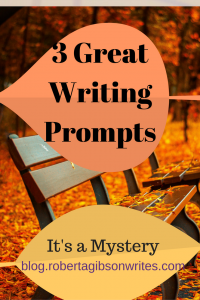Yesterday afternoon I led our local writing group. The members of the group, called Writer’s Studio, free write for about twelve minutes in response to a writing prompt. When we’re finished, those who choose to read what they wrote. Once everyone has shared, we write again. I thought I’d share the writing prompts I used.

Our writing prompts:
1. Write about Halloween
We celebrated both Halloween and Dia de los Muertes this week. Either write about a memory associated with the holiday of your choice, or concoct a scary story. Be sure to include dialogue.
If you are stumped, try writing about Halloween from the point of view of a costume, or — here’s a “sweet” idea — from the point of view of a piece of candy.
2. Use a physical object to inspire a story.
After putting out some random objects on a table (a small teddy bear, rocks, paintbrush, glove, toy cars, etc.), I talked about how an author used real objects to get a story idea.
In a webcast few years ago, Kate DiCamillo discussed writing her award-winning children’s book, Flora & Ulysses: The Illuminated Adventures.
She revealed two of the main elements in the book came from real objects, each of which had deep emotional impacts on her.
The squirrel in the book was based on a real squirrel who had showed up on Kate’s front porch. She said it was sick, so she called a neighbor for advice about what to do. The neighbor suggested a method for dispatching it (which I will not repeat here.) Fortunately, the squirrel left the porch on its own. Sympathy for the squirrel’s plight made her remember the event.
The second item was a vacuum cleaner that Kate saw whenever she entered her garage. The vacuum cleaner had been her mother’s and her mother had recently passed away. Again, it was an object that elicited strong emotions.
Stories are always best with some underlying conflict. In the book, the two real life objects came together as a vacuum cleaner sucked up a squirrel, leading to some unexpected consequences. Be sure to incorporate conflict into your story.
3. Writing Lists as Poems
The Pillow Book by Sei Shonagon and Meredith McKinney (Translator, Introduction) inspired our final writing exercise.
Sei Shonogan was a Japanese writer/poet who lived around the year 1000. People still read a collection of her writings called The Pillow Book.
In the book, many of Shonogan’s poems take the form of lists.
Things that Pass by Rapidly
A boat with its sail up.
People’s age.
Spring. Summer. Autumn. Winter.
~ Sei Shonogan
My own examples:
Things my cat George likes:
Rubbing faces when he gets up in the morning
A dropped Cheerio
The top of the cat-scratching post
Chasing ping-pong balls down the stairs
Things I like:
My cat George
Things that I smell on my morning walk:
Wet dogs
New grass
Car exhaust
Dryer sheets from someone’s laundry
Breakfast cooking on Sunday mornings
Things I hear on my morning walk:
Dogs barking
Leaf blowers
Cars and trucks on the main street
Birds singing
Ducks quacking
The sound of my two feet on pavement
Write a list-inspired poem.
Let us know if you use any of these writing prompts.
______
Related: See our previous post about writing prompts






Leave a Reply